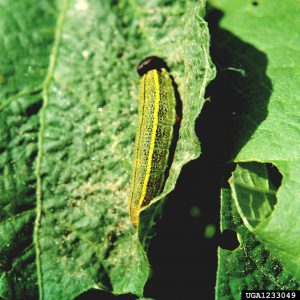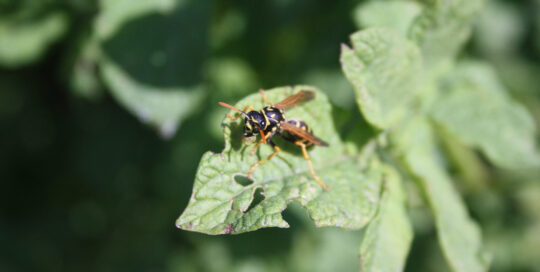Dealing with Leafrollers
Views: 9758

Sometimes it takes a little detective work to figure out what’s eating your plants. That’s not the case with leafrollers, who make their presence known by the signature curling of leaves.
There are hundreds of species of leafrollers, but most share the same characteristic of the caterpillar. They curl the leaf around itself like a straw as it feeds. This protects itself (at least in theory) by birds and other animals who like to eat them. They’re found on a wide variety of plants, from strawberries to beans to practically any type of deciduous tree.
How to Prevent Leafrollers
As with many of our garden pests, the leafroller’s lifecycle begins with an innocent looking moth. These moths lay the eggs in the fall, which overwinter on plant materials in the garden. In the spring, the eggs hatch and the larvae find their way to the growing plants that are their food source. This is the critical time, since catching them before they roll up in the leaves is the most effective time to eliminate them.
But that’s the tough part. Some years you might have a few rolled leaves, which is no big deal, while others are enough to cause serious issues. Once you have the actual leaf rolling, it’s harder to gain control of the situation because the insects are protected from the sprays, as well as the predators.
When you’re assessing the situation, the first consideration should be, “How bad is it?” In many instances, you won’t need to do anything except pull off the affected leaves and dispose of them.
If you’ve had issues with leafrollers on your plants or trees in previous years, there are a couple of ways to be proactive. The easiest thing to do is rake the area underneath the plants in the fall. By disturbing the eggs, you are minimizing the numbers that will hatch. Then keep a close eye on the plants or trees in the spring. Look for damage to the leaves. This is the best time to strike, and thankfully, if you catch them early enough, you don’t have to use harsh means to get rid of them. They’re not that durable.
Organic Sprays
A couple of organic options include using Bt or Spinosad sprays. Both are bacterium that are harmful to a wide variety of insects.
There are protein crystals in Bt (Bacillus thuringiensis) that breaks down the gut wall in the insect and proliferates throughout the body. While it’s naturally found in soil, it’s effective when consumed after being applied directly to the plant.
Spinosad is similar to Bt, as it’s also a naturally occurring bacterium, and although I’ve used it to control grasshoppers, I didn’t know its unique origination. The bacterium Saccharopolyspora spinosa was found in the soil of a former rum distillery in the Virgin Islands. I don’t know if the scientist was on vacation, as I’ve read in some reports. However, I do know (based on the publication from The Journal of Antibiotics) that Eli Lilly was working on finding non-traditional microorganisms. I think it’s a hoot. I mean, who else but a scientist would think of sampling soil at a rum distillery?
More Sprays
But I digress. You can use either of these, particularly on edible crops, to eliminate leafrollers. Do keep in mind that both of these can be detrimental to honey bees, as well as the targeted species. For bigger problems, such as fruit or ornamental tree infestations, you can still employ organic methods, although you will need to be diligent in reapplications, and must ensure the entire tree is covered.
For more draconian measures, there are plenty of synthetic formulations that will do the job. Products with carbaryl (Sevin) will do the trick. Please be sure to follow the manufacturer’s label. There’s no sense in using it unless you’re going to use it correctly.
There are definitely a lot of different leafrollers out there to plague your yard and garden. Fortunately, you can take care of many of them by being diligent, and employing sprays if you really need to knock down the numbers.
I was granted permission to use the photo of the bean leafroller by Clemson University – USDA Cooperative Extension Slide Service via Bugwood.org.
Meet Amy Grisak
Amy is a freelance author and photographer in Great Falls, MT who specializes in gardening, foods, and sustainable agriculture. She provides information on every kind…
Amy's Recent Posts

Looking into the Crystal Ball for a Pest Report








